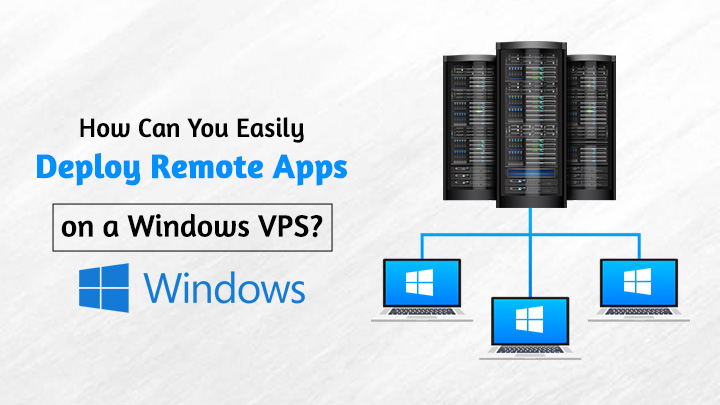

26 Aug 2025 Blogs
Nowadays, many businesses are increasingly adopting hybrid and remote work models. The demand for secure and efficient remote applications continues to grow. The modern work environment needs a solution that allows users to access important applications and data securely from any location. Remote access should have a flexible alternate solution to free businesses from traditional office-based working and IT constraints. This is where Windows VPS with Remote Desktop comes into the picture.
It enables the team to stay productive no matter where they are, in the office, at home, or on the go. You no longer need to rely on heavy hardware or constant on-site maintenance to keep things running. Even if you are not technically sound enough, you can access applications with ease through a familiar Windows interface.
IT teams gain more control over deployments, security policies, and user permissions. Businesses save time, reduce costs, and improve response times with centralized management. Most importantly, it gives your team the freedom to work securely, without boundaries.
At DHS Cloud Services, we simplify Remote App deployment with Windows VPS and Remote Desktop, backed by 99.9% uptime, Tier 3 data centers, and 15-minute SLA support. You can access the VPS anytime and anywhere with ease.
Picture this: you are managing a distributed team that needs access to important apps no matter where they are working from. That’s where Windows VPS with Remote Desktop plays an important role. You can deploy remote apps easily that feel like using software on a local machine. Hosted in a highly reliable environment, your apps stay online and responsive, even during busy hours.
If businesses start using Windows VPS with Remote Desktop, you can publish specific apps for your users, giving them access to only what they need, without exposing your full server. You get full admin control, dedicated system resources, and a secure connection every step of the way. Whether it’s finance tools, CRMs, or custom software, everything runs smoothly without the usual hardware headaches. And with responsive support just minutes away when you need it, managing remote apps becomes simple and stress-free. Want to know how you can deploy remote apps with Windows VPS? Continue reading below:
How do you get started with your Windows VPS with Remote Desktop? Before deploying remote apps, ensure your Windows VPS with Remote Desktop is properly set up and ready. This means having a clean, secure environment where you have full administrative access.
Setting up your VPS is like preparing a blank canvas; once it’s ready, you can customize it to fit your team’s unique workflow. With a solid VPS foundation, your remote apps will run smoothly and securely, helping your team stay productive no matter where they are.
Getting the right software roles installed on your virtual server hosting is a crucial step. You can think of it like adding essential tools to your workspace. By installing the Remote Desktop Services role, your VPS gains the ability to handle multiple remote sessions and deliver apps seamlessly.
This step transforms your virtual server hosting into a powerful platform, ensuring users can access the applications they need without delay or downtime.
Wondering how to make your applications available through Windows VPS? Publishing remote apps allows you to provide your team access to only the software they need, without exposing the entire desktop environment. This targeted approach is perfect for security and efficiency.
With Windows VPS with Remote Desktop, publishing apps is an easy process, letting your users feel like they are running the apps locally, even though everything is hosted remotely. It’s about making technology invisible so your team can focus on their work.
Managing who can see and use your apps on your virtual server hosting keeps your work environment safe and organized. Assigning proper user permissions ensures everyone has the right level of access without risking security. These platforms let IT teams tailor access controls easily, giving peace of mind that sensitive data and applications are only available to authorized users.
How do you protect your Windows VPS with Remote Desktop from threats? Security should never be an afterthought. With Windows VPS with Remote Desktop, you can implement advanced protections like multi-factor authentication and encryption to keep your data safe.
It’s like locking the doors and windows of your digital workspace. Ensuring your VPS is secure means your remote apps remain trustworthy and your business stays compliant with industry standards.
Once everything is set up on your virtual server hosting, it’s time to connect and make sure things work as expected. Testing the remote apps ensures your team can access the right tools quickly and without glitches. This final check on your virtual server hosting setup helps catch any issues early and guarantees a smooth experience for end users.
How can you keep your Windows VPS with Remote Desktop running smoothly over time? Ongoing monitoring and maintenance are key to long-term success. With Windows VPS with Remote Desktop, regular checks on performance, security, and resource usage help prevent downtime and keep your apps responsive.
With proactive monitoring, you can focus on growing your business, knowing your remote app environment is reliable.
At DHS Cloud Services, we make deploying remote apps on Windows VPS simple and effective. Our solutions are designed to deliver reliable performance and seamless access, so your team can stay productive from anywhere. Here’s what you can expect when you choose us:
● 99.9 % uptime guaranteed.
● Faster app access and execution
● Enhanced security with multi-factor authentication
To conclude, deploying remote applications on Windows VPS with Remote Desktop can simplify your daily business operations. With the right setup, you can give users secure, real-time access to business-critical tools from anywhere.
At DHS Cloud Services, we make the entire process simple, secure, and scalable, so you can focus on growing your business, not managing infrastructure.